©
2004 Jeff Matthews & napoli.com
Aqueduct,
Roman—
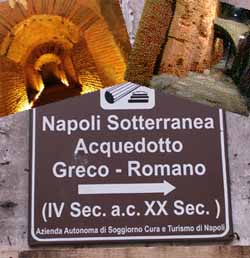 For
those who are not claustrophobic—nay, for those who absolutely
revel in their claustrophilia—I recommend a visit to the Roman
aqueduct system that supplied Naples. It is one of the most impressive
feats of engineering undertaken in Naples during the reign of Caesar
Augustus. The aqueduct was 170 km long and started at a reservoir fed
by the river Serino. There were two branches: one led to Beneventum
and the other to Neapolis. The one to Naples approached the city
from the slopes of Capodimonte, then went on to Vomero and to Posillipo,
the hill bounding the western end of the city. From Posillipo, a secondary
branch lead through the hill and to Fuorigrotta and beyond, to Puteoli,
modern day Pozzuoli. Parts of the aqueduct were open and others
were tunnels through the rock. For
those who are not claustrophobic—nay, for those who absolutely
revel in their claustrophilia—I recommend a visit to the Roman
aqueduct system that supplied Naples. It is one of the most impressive
feats of engineering undertaken in Naples during the reign of Caesar
Augustus. The aqueduct was 170 km long and started at a reservoir fed
by the river Serino. There were two branches: one led to Beneventum
and the other to Neapolis. The one to Naples approached the city
from the slopes of Capodimonte, then went on to Vomero and to Posillipo,
the hill bounding the western end of the city. From Posillipo, a secondary
branch lead through the hill and to Fuorigrotta and beyond, to Puteoli,
modern day Pozzuoli. Parts of the aqueduct were open and others
were tunnels through the rock.
That Posillipo
aqueduct runs parallel to the Roman tunnel known as the Seiano
Grotto and was apparently built at the same time as the tunnel,
itself. The tunnel is occasionally open for visits. As far as I know,
the aqueduct is not; I know of its existence only because I was led
into it by a crazy archaeologist friend of mine. It was there that I
found out that I don't particularly like to be cooped up in tight spaces
beneath mountains.
In the
city of Naples, itself, the water distribution was by a system of subterranean
conduits leading from the main aqueduct. More recently, during the aerial
bombardment of WW II, the ancient aqueduct was put to use as an air-raid
shelter, the wells and cisterns being enlarged to allow for the passage
of people. There are underground tours available of the section of the
aqueduct directly below the historic center of the city. The aqueduct
is appropriately dark, deep, and scary. Visitors are even issued candles
to light their descent. It is also very, very cold, which makes it the
perfect place to visit in July and August. The entrance is from Piazza
Gaetano near the intersection of via dei Tribunali and via
San Gregorio Armeno. (At #33 on the map of the historic center of
the city. Click here.)
Bourbons
(6); Savoy (4)
 Concerning
the visit of the Savoys to Naples, the city of Naples backtracked and
accepted a gift from Victor Emanuel and also turned to flapdoodle the
official line that the Savoys are "just private citizens like anyone
else and we aren't going to baby-sit them". Indeed, the mayor of Naples,
Mrs. Iervolino, and the ex-mayor (now president of the Campania region),
Mr. Bassolino, both showed up to say hello. Concerning
the visit of the Savoys to Naples, the city of Naples backtracked and
accepted a gift from Victor Emanuel and also turned to flapdoodle the
official line that the Savoys are "just private citizens like anyone
else and we aren't going to baby-sit them". Indeed, the mayor of Naples,
Mrs. Iervolino, and the ex-mayor (now president of the Campania region),
Mr. Bassolino, both showed up to say hello.
The ex-Royal
family (photo) of Italy got to sit in the ex-royal box (now the presidential
box) at San Carlo; Victor Emanuel got to visit the building he was born
in (the Royal Palace); and they all went to the Brandi restaurant (which
made the first "Margherita" pizza for Victor's great-grandmother). Young
"prince" Filiberto took in a soccer match at San Paolo and watched home
team Naples struggle to a scoreless tie, thus continuing a nosedive
out of the B League—already a "minor" league—into the very
minor C League.
There were
a few demonstrations, both pro and con. The pros were old-line monarchists
who didn't vote for the Republic in the referendum of 1946. They have
a few modern sympathizers, although it is fair to say that most modern
Italians accept their republic (whatever it faults) as a way of life
and view the Italian monarchy as a relic—which it is.
A recent
copy of the Neo-Bourbon newspaper, Journal of the Two Sicilies.
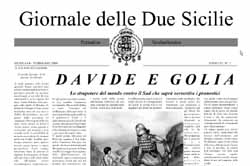 The
most curious demonstrators were the "antis". Some of them were simply
republicans and against monarchies. Their point was to demonstrate against
any sort of official kow-towing to a Man Who Would Be King—although
that is not going to happen and everyone knows it. What caught the eye
was the strange cult of "neo-Bourbons" that showed up with signs that
read "Assassins!" and "Hyenas!" The
most curious demonstrators were the "antis". Some of them were simply
republicans and against monarchies. Their point was to demonstrate against
any sort of official kow-towing to a Man Who Would Be King—although
that is not going to happen and everyone knows it. What caught the eye
was the strange cult of "neo-Bourbons" that showed up with signs that
read "Assassins!" and "Hyenas!"
It is an
oft-repeated assertion in the south of Italy that all of the problems
of the south started with the union of Italy in 1860 under the Savoy
dynasty. That is when the problem of "Two Italys" started, when unemployment
started, and when massive emigration started to deplete the greatest
resource any nation has—its people.
While it
is true that the north bungled the unity of Italy by failing to deal
with the problems of the south, they didn't invent those problems. To
a large extent they inherited them. The entire course of the 19th century
in Italy is bound up in the risorgimento, the movement to create
a united, modern nation state of Italy out of the geopolitical jigsaw
puzzle that had existed on the peninsula for over a thousand years.
That drive to unity was not a northern invention, either. Many of the
"philosophers of unity" such as the historian, Vincenzo Cuoco, were
from Naples. The Kingdom of Naples was also the home of the "carbonari" in the 1820s, the first agitators
for unity, whose ideals fed into the risorgimento later in the
century.
That movement
towards a united Italy was totally resisted by the Bourbons.
For three decades leading up to Garibaldi's
invasion of the south in 1860 to force union on the Kingdom of Naples,
the Bourbon dynasty of Naples was a despotic, absolute monarchy. It
resisted even granting a basic constitution and parliament to the people,
and it had to rely on Austrian and Swiss mercenaries to prop up the
kingdom because the king no longer even trusted his own officer corps,
many of whom were agitating for a united Italy as a sort of "manifest
destiny". The Bourbon kings remained oblivious to the political reform
movements that were sweeping all of Europe in the middle of the 19th
century. They had their century—the 18th—and they liked
it just fine, thank you very much.
Economically,
the north also inherited a largely agricultural society with a system
of land management based on large holdings worked by a permanently poor
class of farmers, a system that had not changed much since the feudalism
of the Middle Ages. This, after much of northern Italy and Europe had
gone over to metayage—tenant farming, where the people
who worked the land kept a considerable portion of what they produced.
The "neo–Bourbons"
fail to mention that as Garibaldi marched north from Sicily towards
Naples in the summer of 1860, he was seen largely as a liberator by
the long-suffering peasantry. He then spent almost a year as "Dictator
of Naples" making Karl Marx seem like a cautious reformer. Garibaldi
expropriated land barons and gave the land to farmers. He set up free
schools as a cure for illiteracy, which was endemic in the south. If
the Savoys are guilty of a historical crime, it is that they undid those
reforms the minute they put Garibaldi out to pasture.
But bring
back the Bourbons? They must be kidding.
Cars (2)
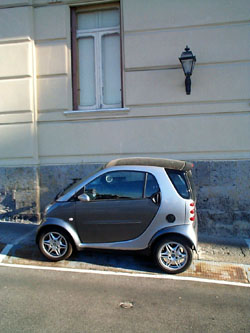 I
'm not sure what kind of foreign car is the most popular in Naples.
You see a lot of the official car of Lilliput nowadays, the Smart,
a two–seater (photo). It is made by Mercedes and Swatch (from
Swiss Watch, the gnomes who make those screwy–looking transparent
wristwatches where you can actually see the springs and cogs of the
works. The Smart is not cheap, in spite of its diminutive size, but
it is easy to park, which I suppose is an advantage. I did know one
of the nouveaux riches in Naples who had the ostentatiously bad
taste to get himself a Rolls Royce. I have no idea if he ever took it
out of the garage. I have no idea even where the garage was; it was
probably some sort of a secret cavern where he could enwomb himself
in his expensive toy in solitude, fondle the steering wheel and feel
completed in life. There are a few Mercedes around—the real ones:
somber, well designed, solidly built, wall-to-wall airbags and even—as
an optional—a cigar-smoking industrialist in the back seat. There
are some Volvos and Saabs, too. Having a new high–tech German
or Swedish set of wheels around here, though, is asking for trouble.
There is a big market for them, and they say that if you park one in
the wrong part of town, some sheikh will be driving your car around
downtown Riyadh a few days from now. I
'm not sure what kind of foreign car is the most popular in Naples.
You see a lot of the official car of Lilliput nowadays, the Smart,
a two–seater (photo). It is made by Mercedes and Swatch (from
Swiss Watch, the gnomes who make those screwy–looking transparent
wristwatches where you can actually see the springs and cogs of the
works. The Smart is not cheap, in spite of its diminutive size, but
it is easy to park, which I suppose is an advantage. I did know one
of the nouveaux riches in Naples who had the ostentatiously bad
taste to get himself a Rolls Royce. I have no idea if he ever took it
out of the garage. I have no idea even where the garage was; it was
probably some sort of a secret cavern where he could enwomb himself
in his expensive toy in solitude, fondle the steering wheel and feel
completed in life. There are a few Mercedes around—the real ones:
somber, well designed, solidly built, wall-to-wall airbags and even—as
an optional—a cigar-smoking industrialist in the back seat. There
are some Volvos and Saabs, too. Having a new high–tech German
or Swedish set of wheels around here, though, is asking for trouble.
There is a big market for them, and they say that if you park one in
the wrong part of town, some sheikh will be driving your car around
downtown Riyadh a few days from now.
I may have
been the only person in Naples with an American Motors Corp. Concord,
a fine machine from 1979. It used to draw stares, "oohs" and "aahs"
when I brought it up out of my own Bat Cave for my nightly patrols through
the by-ways of Naples. It wasn't what Europeans disparagingly term an
"American battleship". They are remembering way back when—the
1950s—when American drivers were shameless love–slaves of
the Godzillamobile, a gaudy behemoth with tail-fins aerodynamically
honed to create intense low pressure vortices in their wake, vacuuming
up little old ladies from curbside and blowing them down the streets
like geriatric Dorothys on their way to Oz. One turn signal, alone,
pulled more juice than it took to reanimate Boris Karloff in The Return
of Frankenstein, and in fossil–fuel consumption, those cars barely
got two miles to the dinosaur. My Concord wan't any of that—it
just wasn't a "European-looking" car.
Still way
back when, my parents indeed bought a European-looking car. It looked
that way because it was a European car—a small Citroen 2CV. We
made a trip from Los Angeles to New York and back. The 2CV made it,
suffering no more than an occasional hayseed jibe about us having to
scrounge spare parts from boxes of Cracker Jacks. It was a good car,
not fragile—in spite of the salesman's warning not to kick the
tires.
It made
that trip fine, just the way I made it fine in my last big trip in the
Concord--way up to Switzerland, even motoring up over the Alps instead
of through the long, dreadful Gotthard tunnel. On the way back down
south, I strayed from the autostrada near Naples onto a road that even
the world's greatest optimist might call "What Road?!"—
a trail ludicrously overrated on my map as a vague tracing of broken
squiggles. I wound up in a village where children fled from my path
and wide-eyed peasants threw sprigs of wolfbane at my car. (Or maybe
it's "cloves" of wolfbane, or some metric unit like "kilobushes".)
I pulled
up in front of City Hut to ask directions, and a village elder appeared.
He eyed my car suspiciously since it had just been seen to move without
benefit of harnessed brute. Helpfully, he set the townsfolk to sharpening
stakes and gathering firewood until I explained with my map that it
had been all downhill from Switzerland. He was impressed, too, that
Switzerland was a mere eleven inches from his village. He seemed fully
conversant with the technology of the wheel since he tried to converse
with my tires. When they wouldn't answer, he stared kicking them, shaking
his head and "tsk–tsking" as he went. I turned down his offer
of a trade–in for a fine, slightly used mule. He even kicked the
poor animal in the shins a few times just to show me what a good, solid
beast it was. In any event, they let me go and I drove off back to Naples,
but only after letting every adult in the village sit in the front seat
of my Concord, fondle the steering wheel and feel completed in life.
| I
am beginning to see that agriculture will not be perfect in a people
until those who farm the land are the same ones who own the land. |
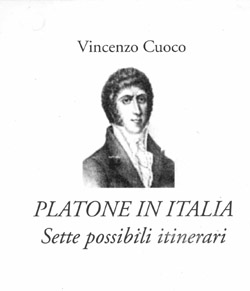 When
I read that, I immediately think of revolutionaries and reformers from
the middle of the 19th century. Yet, the words were written a bit earlier
than that, and they come from a source that, perhaps, many non–Italians
have not heard of: Vincenzo Cuoco, a Neapolitan historian who lived
from 1770 to 1823. When
I read that, I immediately think of revolutionaries and reformers from
the middle of the 19th century. Yet, the words were written a bit earlier
than that, and they come from a source that, perhaps, many non–Italians
have not heard of: Vincenzo Cuoco, a Neapolitan historian who lived
from 1770 to 1823.
Cuoco was
caught up in the spirit and times of late 18th–century Europe:
Enlightenment and Revolution. He was part of the Neapolitan Enlightenment
and part of the revolution that gave birth to the Neapolitan Republic
of 1799. The Bourbons overthrew the Republic after a few short months
and punished Cuoco by confiscating his property and sentencing him to
20 years of exile. Then, when the French took over the Kingdom of Naples
in 1806, he returned home and took an active part in the 10-year French
rule in Naples. At the second return of the Bourbons in 1815, he was
permitted to stay in Naples, where he died in 1823, clouded by mental
illness. At least, the Bourbons had spared Cuoco's life in 1799, and
he lived to write the works he is remembered for.
The best
known one is Saggio Storico sulla Rivoluzione Napoletana nel 1799
(History of the Neapolitan Revolution of 1799). He published it anonymously
in 1801 and under his own name in 1806; it is the seminal work for those
interested in that episode of history and, though his view is not the
only one on why the revolution failed, Cuoco is the first to deal with
that question:
Since
our revolution was a passive one, the only way for it to be successful
would have been to gain the opinion of the people. But the view
of the patriots was not the same as that of the people; they had
different ideas, different customs, and even two different languages.
The very same admiration for things foreign, which held back our
culture as a kingdom, formed the basis for our republic and was
the greatest obstacle to the establishment of liberty. The Neapolitan
nation was split in two, separated over two centuries into two
very different kinds of people. The educated classes were formed
on foreign models and possessed a culture quite different from
one that the nation needed, one that could come about only through
the development of our own faculties. Some had become French,
and some English; and those that stayed Neapolitan—most
of the people—stayed uneducated.
[From Saggio Storico sulla Rivoluzione Napoletana nel 1799.
The translation is mine.] |
A lesser–known
work—and the one the quote at the beginning of this log entry
is taken from—is Platone in Italia (Plato in Italy), a
bit of historical fiction in which Cuoco claims to be merely translating
a manuscript written by Plato, himself. Of course, no one believed that,
and Cuoco knew that no one believed that, but it gave him a vehicle
for his ideas on just what was wrong with society and how it could be
remedied.
Platone
in Italia is a series of dialogues between Plato and his disciples
set in Italy during Plato's lifetime—that is, approximately 400
b.c. Cuoco—speaking as Plato—reveals his fascination with
the ancient pre-Roman peoples of Italy, especially the Etruscans and
the Samnites, two cultures older than Greece and which—much more
so than Greece—should serve as a model for modern Italy. Italy
really had nothing to thank the Greeks for, since the Italic cultures
were older than that of Classical Greece. Modern Italians (meaning in
the early 19th century, when Cuoco was writing) had nothing to fear
from the ideas of confederation (like the Etruscans) or a non-feudal
system of land management—small farms owned and worked by the
citizenry (like the Samnites). After all, none of this, says Plato/Cuoco,
is new and revolutionary; it goes way back to our own Italic roots.
The book
is actually amusing in that it has Plato sounding off on various occasions
about how backwards "we Greeks" really are compared to the older and
wiser peoples of Italy. Cuoco, of course, is throwing this in the face
of the cliché that Italy (meaning the Romans) became educated
only after they had conquered Greece and absorbed some wisdom. Platone
in Italia did very well for a number of years—perhaps in the
afterglow of the French Revolution—but it then drifted into obscurity.
I was reminded of all this when I passed the Vincenzo Cuoco Liceo the
other day. He might be happy to know that two centuries later, there
is a high school in Naples named for him.
"Little
King," the ("Reuccio")
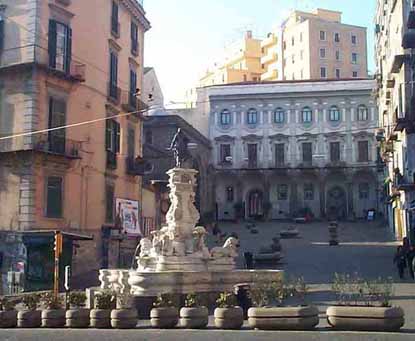 Affectionately
called the Il Reuccio"—the "little king" —by
Neapolitans, Charles II (1661-1700), King of Spain, was the last
ruler of the once mighty Spanish empire and, thus, is the last
in the line of Spanish monarchs to rule Naples. He died without an heir
and designated as his successor Phillip of Bourbon , Duke of Anjou,
and nephew of the king of France. This effectively turned France and
Spain into allies, a union potentially so strong that England, Holland,
and the Holy Roman Empire of Leopold I formed a Grand Alliance to fight
it. This set off the Wars of the Spanish Succession, which raged
across Europe until 1713. The statue in the photo is at Piazza Monteoliveto,
one block up from the main post office on Via Monteoliveto. Affectionately
called the Il Reuccio"—the "little king" —by
Neapolitans, Charles II (1661-1700), King of Spain, was the last
ruler of the once mighty Spanish empire and, thus, is the last
in the line of Spanish monarchs to rule Naples. He died without an heir
and designated as his successor Phillip of Bourbon , Duke of Anjou,
and nephew of the king of France. This effectively turned France and
Spain into allies, a union potentially so strong that England, Holland,
and the Holy Roman Empire of Leopold I formed a Grand Alliance to fight
it. This set off the Wars of the Spanish Succession, which raged
across Europe until 1713. The statue in the photo is at Piazza Monteoliveto,
one block up from the main post office on Via Monteoliveto.
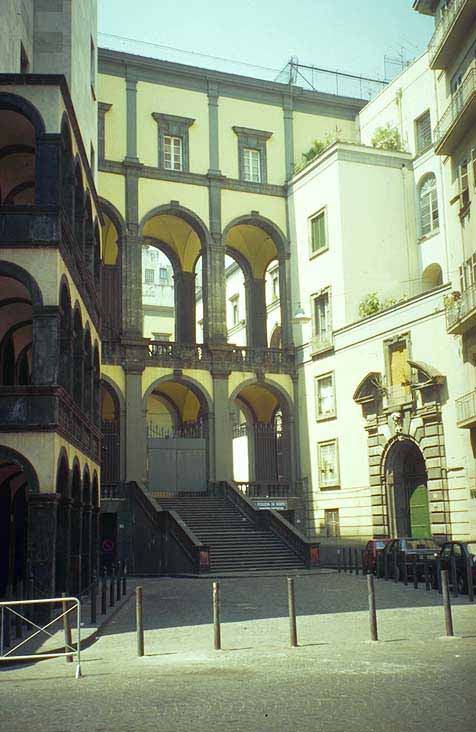 The building seen
behind the statue in the photo is of extreme interest. It is part of
what was once one of the largest monasteries in Italy and is, perhaps,
the least written about of all such religious structures in Naples.
Construction started in 1411 and over the centuries devopled into a
mini-city inhabited by members of the Monteolivetan order. The complex
was largely broken up in the wake of the suppression of monasteries
in Napoleonic Europe in the early 1800s and has undergone
subsequent subdivision. The part in view behind the statue in
the photo is currently a large barracks for the Carabinieri, the uniformed
Italian national police force. (The dark building attached to the left
of the barracks is the Church of Monteoliveto --still a church.) The
entire complex stretched further downhill to the south for 150 yards
to the main cloister of the monastery. That part of the complex is closed
but was left intact and actually incorporated into the main Naples post
office when that building was put up in the 1930s (photo at right).
In effect, the entire modern city block surrounds the old monastery. The building seen
behind the statue in the photo is of extreme interest. It is part of
what was once one of the largest monasteries in Italy and is, perhaps,
the least written about of all such religious structures in Naples.
Construction started in 1411 and over the centuries devopled into a
mini-city inhabited by members of the Monteolivetan order. The complex
was largely broken up in the wake of the suppression of monasteries
in Napoleonic Europe in the early 1800s and has undergone
subsequent subdivision. The part in view behind the statue in
the photo is currently a large barracks for the Carabinieri, the uniformed
Italian national police force. (The dark building attached to the left
of the barracks is the Church of Monteoliveto --still a church.) The
entire complex stretched further downhill to the south for 150 yards
to the main cloister of the monastery. That part of the complex is closed
but was left intact and actually incorporated into the main Naples post
office when that building was put up in the 1930s (photo at right).
In effect, the entire modern city block surrounds the old monastery.
[Also
see here for an item on the modern use
of old monasteries.
Parthenope,
Ulysses
| When
we had got within earshot of the land, and the ship was going
at a good rate, the Sirens saw that we were getting in shore and
began with their singing.'Come here,' they sang, 'renowned Ulysses,
honour to the Achaean name, and listen to our two voices. No one
ever sailed past us without staying to hear the enchanting sweetness
of our song—and he who listens will go on his way not only
charmed, but wiser, for we know all the ills that the gods laid
upon the Argives and Trojans before Troy, and can tell you everything
that is going to happen over the whole world.'
They
sang these words most musically, and as I longed to hear them
further I made by frowning to my men that they should set me
free; but they quickened their stroke, and Eurylochus and Perimedes
bound me with still stronger bonds till we had got out of hearing
of the Sirens' voices. Then my men took the wax from their ears
and unbound me.
—The
Odyssey (trans. Samuel Butler)
|
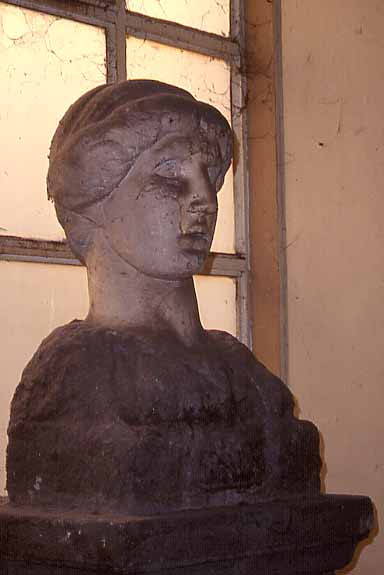 Like
most of my generation, I got my classical education from the venerable
Classic Comics. I grew up thinking that most of that ancient Greek stuff
happened—well, over in Greece somewhere. Little did I know that
the episode of the Sirens took place in these waters. There are tiny
rocks sticking up out of the water on the Amalfi side of the Sorrentine
peninsla named for those very Sirens that tempted Ulysses. One of the
Sirens, Parthenope, threw herself into the sea out of despair over what
she believed to be her lack of allure, and her body washed up on the
coast a few miles away at the spot where mythology says the city
of Neapolis (Naples) was founded. Actually, that would be the city of
Parthenope, which then became Neapolis; indeed, modern Neaplotans still
refer to themselves commonly as "Parthenopeans". Like
most of my generation, I got my classical education from the venerable
Classic Comics. I grew up thinking that most of that ancient Greek stuff
happened—well, over in Greece somewhere. Little did I know that
the episode of the Sirens took place in these waters. There are tiny
rocks sticking up out of the water on the Amalfi side of the Sorrentine
peninsla named for those very Sirens that tempted Ulysses. One of the
Sirens, Parthenope, threw herself into the sea out of despair over what
she believed to be her lack of allure, and her body washed up on the
coast a few miles away at the spot where mythology says the city
of Neapolis (Naples) was founded. Actually, that would be the city of
Parthenope, which then became Neapolis; indeed, modern Neaplotans still
refer to themselves commonly as "Parthenopeans".
I have
found what I understand is the only piece of ancient sculpture in Naples
depicting the siren, Parthenope. It is a small bust, and is located
on the premises of the Municipio, the City Hall. It was recovered from
the site of the original Greek acropolis of the city of Neapolis, on
the height across from today's Piazza Cavour. That location is not currently
an active archaeological site, and it has been covered with centuries
of construction, most recently various departments of the University
of Naples Medical School. On the historic map of the city (click here) you would start at #37 and walk up the hill
(towards the top of the map).
Maintenance
and upkeep, Mostra d'Oltremare, Piazzale Tecchio
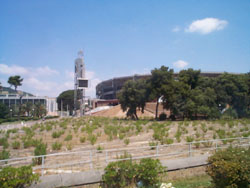 My
theological qualifications are ridiculously peccable, so when I say
I couldn't find a Patron Saint for those who perform Maintenance and
Upkeep, I may, indeed, have missed him or her. There is Expeditus (also
known as Elpidus), the saint against procrastination and for expeditious
or prompt solutions. Also, Saint Barbara and Saint Thomas the Apostle
(better remembered as "doubting") are both listed as saints for construction
workers. All of these are close to what I am looking for…but… My
theological qualifications are ridiculously peccable, so when I say
I couldn't find a Patron Saint for those who perform Maintenance and
Upkeep, I may, indeed, have missed him or her. There is Expeditus (also
known as Elpidus), the saint against procrastination and for expeditious
or prompt solutions. Also, Saint Barbara and Saint Thomas the Apostle
(better remembered as "doubting") are both listed as saints for construction
workers. All of these are close to what I am looking for…but…
One of
the most maddening things about Naples is that they build beautiful
things and then let them fall apart. Some years ago, they city decided
to redo the square in front of the San Paolo soccer stadium, Piazzale
Tecchio. They turned it from a squalid clot of traffic and noise into
a vast pedestrian zone, replete with banks of brick bleacher-type seats
for students from the adjacent university buildings and a large area
surfaced with natural, rough-hewn wooden planks. All that plus the new
trees gave the students and passers–by a pleasant place to sit
outside in a busy city and enjoy their lunch and maybe a fine day.
I passed
by that spot yesterday and the wooden surface is rotted and warped,
and there are weeds growing up between the cracks (photo). Years of
weathering and no maintenance will do that. As a result, the entire
area is closed and cordoned off by that orange plastic web fencing that
they string around construction sites to keep lollygaggers away. That,
too, has been pushed down and trampled underfoot in places by pedestrians
trying get across the square along the narrow walkway that has been
left open. Bare, rusted spikes that held the fence in place stick up
along the route. It's a pit.
The stadium
is adjacent, also, to the east end of the mammoth Mostra d'Oltremare—the
Overseas Fair Grounds—an area about one mile long by several hundred
yards wide. It was opened in the late 1930s and was part of the Fascist-era
splurge of construction in Naples. It had thousands of Mediterranean
pine trees, a zoo, buildings for expositions, and—the crown jewel—the
arena flegrea, an outdoor theater, the backdrop of which was
a colourful mosaic. The wings led from both sides to access paths around
to the production area where props were stored. Through the 1950s, summer
productions of Aida were an annual event. The most spectacular
feature at the Mostra was a suspension cable-car that led from the fair
grounds up and over the trees to a point on the Posillipo ridge hundreds
of yards distant and 300 feet above sea-level to overlook the entire
bay of Pozzuoli to the west.
The zoo
is still there, as are many of the trees, but the fountain has not fountained
in years, nor has the theater been used in decades. Many of the buildings
have fallen to ruin, and if you wander into the still ample wooded sections,
you can see what is left of buildings jutting out or toppled over. In
many cases, newer and very ugly buildings have been put up over the
years in that formless quick–and–dirty prefabricated slab
style of the 50s and 60s. The grounds are still used to host yearly
events such as book and computer fairs, and some university buildings
are also on the premises. The cable lift to Posillipo has, of course,
not run since the 1950s.
There are
two possibilities, both of which have to do with my search for the right
saint: one, either the saint does not exist and, thus, those people
charged with keeping things looking spiffy and fine have no need to
curry favor with the gods; or, two, the saint does exist and those same
people figure they don't have to worry about it because the saint has
it covered. This is a Thomistic dilemma, indeed, and I tremble before
it.
Seiano
Grotte (1)
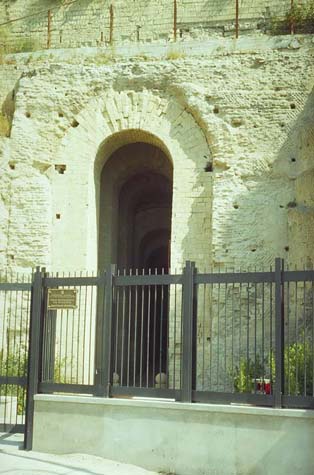 As early as the Republic of Rome and then during the first centuries
of Empire, the coastal area of the Bay of Naples was the site of a number
of aristocratic residences. One of the best-loved places to put your
aristocratic villa in those days was on the seaside slope of the great
hill of Posillipo at the western end of the bay. The name Posillipo
—Greek for "the place where unhappiness ends" expresses the
sense of serenity which Imperial Romans must have derived from this
lovely promontory. Recent excavations along the seaside in the area
of the small island of Gaiola and the nearby coastal area of Marechiaro
have uncovered numerous traces of Roman habitation, including the ruins
of a theatre built to accommodate some 2,000 spectators, and an odeion,
a theater for musical performances. As early as the Republic of Rome and then during the first centuries
of Empire, the coastal area of the Bay of Naples was the site of a number
of aristocratic residences. One of the best-loved places to put your
aristocratic villa in those days was on the seaside slope of the great
hill of Posillipo at the western end of the bay. The name Posillipo
—Greek for "the place where unhappiness ends" expresses the
sense of serenity which Imperial Romans must have derived from this
lovely promontory. Recent excavations along the seaside in the area
of the small island of Gaiola and the nearby coastal area of Marechiaro
have uncovered numerous traces of Roman habitation, including the ruins
of a theatre built to accommodate some 2,000 spectators, and an odeion,
a theater for musical performances.
A most
singular bit of construction, however, is the spectacular Seiano Grotte,
an 800-meter tunnel through the Posillipo hill itself, from the western
area of modern Bagnoli through to the sea. It was apparently a private
tunnel and allowed easy access to the spectacular clifftop estate of
Vedius Pollio. The tunnel was probably
built by Lucius Cocceus Auctus, the same engineer responsible for the
Gallery of Peace, a tunnel and important part of the fortifications
of the Roman Imperial Port in Baia.) Auctus also built the
major tunnel that the Romans used to get to Naples from the West. (Today,
that tunnel parallels and is between the two modern
traffic tunnels that go from Mergellina through the hill to Fuorigrotta.
It was in common use until the completion of the two recent tunnels,
one in the 1880s and the other in the 1920s.) The Seiano Grotto is high
and spacious; it was ventilated by three air ducts opening on the sea.
It fell into disuse over the centuries, but was later reopened by the
Bourbons in 1841. Bourbon restoration was extensive and provides
interesting comparison to the original Roman masonry evident in many
places. The Bagnoli entrance (shown in the photo) has recently been
restored and, on occasion, the tunnel and grounds of the Vedius Pollio
estate may be visited.
(Also,
see this entry on Posillipo.)
Smorfia
(2), dreams (2)
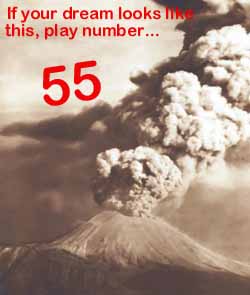 Looking
at the entry for the smorfia, I am still not quite sure what numbers to
play in the lottery this week. I had an ominous dream the other night
and when I try to get some help from the neigborhood stable of oneirocritics
in my morning coffee-bar as to what numbers my dream adds up to—that
is, what symbols (such as "Vesuvius") correspond to what numbers in
the Neapolitan bible for such things, la smorfia—they
get nervous and touch certain parts of the body, which action is said
to ward off bad luck, the evil eye, and all the rest. Looking
at the entry for the smorfia, I am still not quite sure what numbers to
play in the lottery this week. I had an ominous dream the other night
and when I try to get some help from the neigborhood stable of oneirocritics
in my morning coffee-bar as to what numbers my dream adds up to—that
is, what symbols (such as "Vesuvius") correspond to what numbers in
the Neapolitan bible for such things, la smorfia—they
get nervous and touch certain parts of the body, which action is said
to ward off bad luck, the evil eye, and all the rest.
I dreamt
that Vesuvius erupted. Now, I have had the normal run-of-the-mill dreams
of interest to headshrinkers, I suppose, but I have never had any prophetic
dreams. I have read about them, of course, and put them in that part
of my brain-closet where I keep crop circles, aliens, and Atlantis.
Yet, it
was vivid. I had missed a bus for some reason and was running towards
home. I looked up and the volcano was off in the distance, the profile
very clear—more or less as I would see it from where I
live, both cones, Somma and Vesuvius, with the saddle-like depression
between them. Then, Vesuvius, the one on the right, started smoking.
Someone said, "Vesuvius is erupting!" and then the main eruption started—not
a slow, effusive eruption, but a cataclysmic explosion just like the
films I have seen of Mount St. Helens and Pinatubo, where the entire
top of the mountain explodes and then disappears behind the smoke.
I mentioned
the dream to a couple of acquaintances and they were reluctant to comment.
I think I may have trod on some unspoken rule that forbids talking about
such things. You never can tell. I am not sure if there is a time-limit
on the dream-lottery connection. This may take some research.
America's Cup (1)—
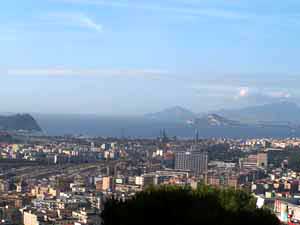 I
remember the town of Bagnoli as the degraded site of a steel mill, a
blight on the potentially beautiful Bay of Pozzuoli. The industrial
plant, of course, was ugly and dirty, and whatever recreational use
the waters might have served was rendered academic by the presence of
a huge industrial pier. I
remember the town of Bagnoli as the degraded site of a steel mill, a
blight on the potentially beautiful Bay of Pozzuoli. The industrial
plant, of course, was ugly and dirty, and whatever recreational use
the waters might have served was rendered academic by the presence of
a huge industrial pier.
As I have
noted in the log entry for Bagnoli, there is underway an enormously ambitious
project to revive the area. The steel mill is already gone, and an impressive
Science City exposition ground is, at least partially, already open
on the premises. The latest wrinkle in bringing Bagnoli back to life
is more ambitious than I could have ever imagined: The America's Cup!
—the boat race. (Not knowing anything about boats and sailing
except what I remember from Captain Blood, I am not even sure
if "race" is the proper term. I should be keelhauled, I know. Avast.
Belay that.)
The Swiss
team, Alinghi, won the recent 31st edition of the America's Cup in New
Zealand and is now searching around the Mediterranean for a site to
hold the 32nd competition in 2007, when they will be called upon to
defend the Cup. There are two Alinghi representatives now in Naples
to scout Bagnoli as a possible site, and there is intense politicking
going on at City Hall to get the race.
Palma di
Mallorca is also mentioned as a candidate. The Neapolitan papers, as
might be expected, tout all the advantages of Bagnoli, from wind conditions
to water depth to the availability of a vast tract of "virgin area"
to develop into facilities to accommodate the 18 craft that will participate.
I have seen the area, and—while there is nothing "virgin" about
it (I shall spare you the lame jokes about "restorative surgery")—much
of it is again available to be redeveloped. If selected, could they
do it four years? I don't think so.
(More
here and here.)
Castel
dell'Ovo (Egg Castle) (1)
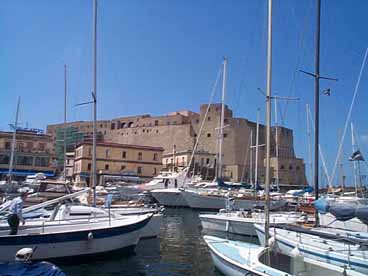
The Castel dell'Ovo (the Egg Castle) is what you
first notice as you stroll along the seaside Villa
Comunale, the Communal Gardens, in Naples. It is a fortress built
on the small island of Megaride, just off the Santa Lucia section of
the city. Here, legend has it, is where the siren Parthenope
washed ashore after throwing herself into the sea when her song failed
to bewitch Ulysses.
Less mythologically,
here is where the Greeks from Cuma to the north first settled the bay of Naples
in the fifth century bc. Centuries later, the island became the home
of the last Roman emperor, exiled here in 476 A.D. after the empire
was overrun by the Goths.
[Various
sources say that the young, last emperor, Romulus Augustulus, was banished
to the "castle of Lucullus" in Campania by Odoacer, whom Gibbon, in
The Decline and Fall of the Roman Empire, called "...that successful
barbarian..." . Gibbon also says, however, that " When the Vandals became
formidable to the seacoast, the Lucullan villa, on the promontory of
Misenum, gradually assumed the strength and appellation of a strong
castle, the obscure retreat of the last emperor of the West." That is
almost certainly a mistake. There were imperial villas on the promontory
of Misenum, but the great villa of Lucullus (from which we derive the
expression, "To live in Lucullan splendor") was indeed on the island
of Megaride, where the Castel dell'Ovo now stands. The ex-last-emperor
was then apparently instrumental in founding a monastery on the island.
There are no reliable accounts of his last years or even of when he
died.]
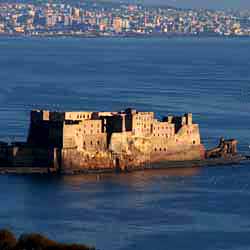 The
fortress that you now see dates back "only" about a thousand years and
is essentially the result of Norman
and Angevin construction done in the Middle Ages.It was then that the
strange legend arose that a thousand years earlier, the poet
Virgil had hidden an egg in the castle, the fate of which would
parallel the fate of Naples, itself. As long as the egg remained intact,
the city would be spared destruction. Thus the unusual name, the Castel
dell'Ovo, or "Egg Castle". The
fortress that you now see dates back "only" about a thousand years and
is essentially the result of Norman
and Angevin construction done in the Middle Ages.It was then that the
strange legend arose that a thousand years earlier, the poet
Virgil had hidden an egg in the castle, the fate of which would
parallel the fate of Naples, itself. As long as the egg remained intact,
the city would be spared destruction. Thus the unusual name, the Castel
dell'Ovo, or "Egg Castle".
The egg,
of course, is in many contexts --from pre-Christian ones to Augustine's
commentary on Luke to Bosch's "The Garden of Earthly Delights" and even
to the popular use of the "Easter egg"-- a symbol of life, resurrection
and hope. Thus, the broken egg stands for spiritual death, and, thus,
at least once in the Middle Ages, a Neapolitan monarch had to go out
and assure the people that the egg had not broken. It was intact --and
Naples was safe.
(For a
more personal view of the Egg Castle, click here.) (Also see here.)
Bellini
(Piazza) (1)
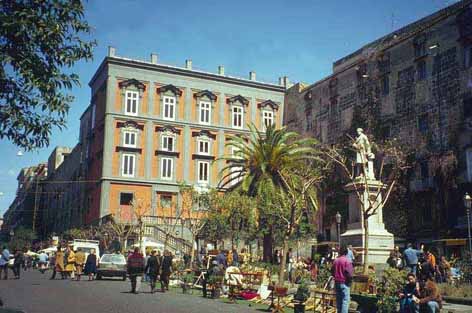 Piazza Bellini is on via Costantinopoli, appropriately
a few yards from the music conservatory,
San Pietro a Maiella. The square is a point where many historical threads
of the city come together as they do in so many places in Naples. Bellini was one of the founders of Italian lyric
opera. He was born in Sicily in 1801, but came to study and compose
in Naples in 1819. The statue, the work of Alfonso Bazzico, shows the
composer above allegorical representations of Norma, Giulietta,
Amina and Elvira, four heroines of his operas. (At least those
smaller pieces of sculpture used to be there. Recently the city
decided to remove them, possibly to protect them from vandalism. There
is no word as to when, if ever, they are to be returned.) Piazza Bellini is on via Costantinopoli, appropriately
a few yards from the music conservatory,
San Pietro a Maiella. The square is a point where many historical threads
of the city come together as they do in so many places in Naples. Bellini was one of the founders of Italian lyric
opera. He was born in Sicily in 1801, but came to study and compose
in Naples in 1819. The statue, the work of Alfonso Bazzico, shows the
composer above allegorical representations of Norma, Giulietta,
Amina and Elvira, four heroines of his operas. (At least those
smaller pieces of sculpture used to be there. Recently the city
decided to remove them, possibly to protect them from vandalism. There
is no word as to when, if ever, they are to be returned.)
The square
is adjacent to a section (photo on right, below) of the original west
wall of the Greek city of Neapolis, the massive blocks still lying where
they were put in place four centuries before Christ. The wall ran the
length of what is now via Costantinopoli, and, presumably, if
you could tear up that street and tear down all the nearby buildings
and dig down a few meters, you would find the whole wall, portals and
all —in addition to making modern residents very unhappy.
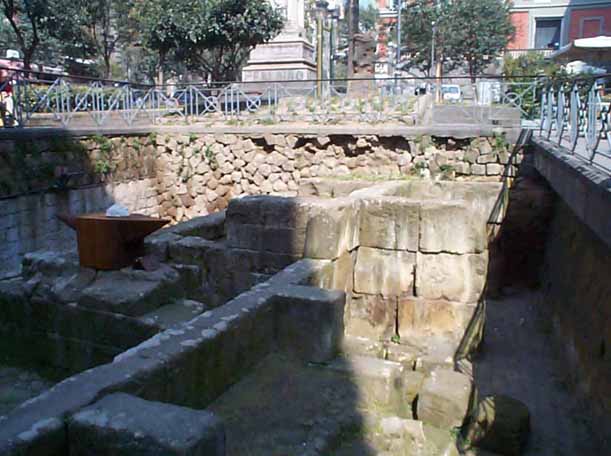
The square
is also at the point along via Costantinopoli where the Spanish chose
to breach the original walls of the city in the first “modern”
expansion of Naples, in the fifteenth century, putting in place the
gate right across the street that now leads to Port’Alba and Piazza
Dante. There are two prominent buildings in Piazza Bellini. The first
is Palazzo Conca, on the composer’s left (not shown here), built
in 1488 and long considered one of Naples’ major repositories
of period furnishings and works of art, belonging, as it did during
its long history, to two of the city’s most important families,
the Concas and, later, the Orsinis.
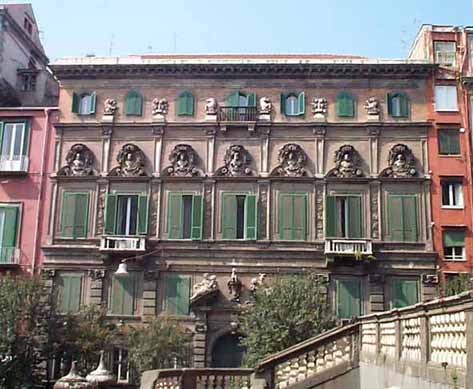
Directly
across from the composer is the Palazzo Firrao (photo on left),
also known as Palazzo Bisignano, built in the 1500s. The Baroque
façade of the building is due to the facelift given the building
in the 1600s by the greatest Neapolitan architect of the age, Cosimo
Fanzago, whose other works in the city include the arched courtyard
within the monastery of San Martino and the chapel in the Royal Palace.
The façade
is ornamental in the extreme and is listed in a 1718 catalogue as one
of the "most conspicuous" in the city. Among other things, the façade
presents an array of statues of seven kings of Spain, ranging from the
15th century to Charles II (1661-1700).
Today,
the square is a gathering place and watering hole for whatever passes
as a ‘Bohemian’ element these days. It is, as noted, right
next door to the music conservatory—and
right down the street from the Royal Art Academy on via Costantinopoli.
Music shops, coffee houses and art galleries abound, and there is an
open-air antique fair on Sundays. (Also, see
here.)
Trains
(1), metropolitana (5)
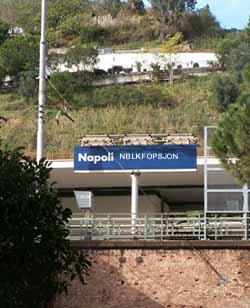 I
had been holed up at the Piazza Garibaldi stop beneath the main
railway station in Naples waiting for the Metropolitana for quite
some time. Still no train. The passengers—or, better, the ticketholders
who aspired to passengerhood—reacted variously. Some shuffled
helplessly like bored cattle. Others looked like zombies playing hopscotch,
stiffly lumbering up and down the platform, their eyes vacantly reflecting
the long dark perspective of the empty tunnels. Many of them looked
used to this ritual. They looked tough. They looked like Donner Party
Survivors. I moved away from them, down to the farthest end of the platform.
If The Night of the Living Dead Metro Riders broke out, I would
escape into the tunnel itself. (I made a mental note to avoid the fate
of those poor souls who had perished in the Great Late Train Riots of
The Week Before when they had become enmeshed in the cobwebs that crisscrossed
the tracks.) I
had been holed up at the Piazza Garibaldi stop beneath the main
railway station in Naples waiting for the Metropolitana for quite
some time. Still no train. The passengers—or, better, the ticketholders
who aspired to passengerhood—reacted variously. Some shuffled
helplessly like bored cattle. Others looked like zombies playing hopscotch,
stiffly lumbering up and down the platform, their eyes vacantly reflecting
the long dark perspective of the empty tunnels. Many of them looked
used to this ritual. They looked tough. They looked like Donner Party
Survivors. I moved away from them, down to the farthest end of the platform.
If The Night of the Living Dead Metro Riders broke out, I would
escape into the tunnel itself. (I made a mental note to avoid the fate
of those poor souls who had perished in the Great Late Train Riots of
The Week Before when they had become enmeshed in the cobwebs that crisscrossed
the tracks.)
I saw that
I had moved right below the mechanical notice board. It had letters
that flip into place to indicate the destination of the next train.
I watched as the letters for my direction clicked over and spelled out,
'P–O–Z–Z–U–O–L–I'. That was
where I was going, so, in spite of whatever other character defects
it may have had, this was a good sign, though perhaps a mite optimistic,
for time continued to pass, time during which, I feel sure, the Great
Red Spot on Jupiter made significant progress across the surface of
that kingly sphere, but also a period during which our Metro station
remained as unsullied and pristine, as gloriously trainless as the Garden
of Eden.
My central
nervous system was now so bored that it threatened to start answering
weird ads in personal columns on its own just for a little action, so
I shifted over a bit and casually, unsuspectingly, looked up at the
other side of the board, the side that would indicate the destination
of trains going the opposite way. It, too, had tiny individual slots
for letters, but they were rightfully blank, since there was only one
more stop in that direction to the end of the line, Gianturco, which
was, however, closed for repairs. A strange thing then happened, something
that made my skin crawl. The sight of my skin slithering towards them
from the far end of the platform was so repulsive to the other passengers
that now they moved further away from me. Above me on the board, concealed
from them, but clear to me, the blank letter spaces had whirred to life
and where there should have been nothing, no destination at all, letters
had slowly flip–flopped into place and now read: 'NBLKFOPSJON'.
It was
only there for a few seconds and I was the only one to see it, but I
am now convinced that Someone or Something somewhere, for reasons that
may never be known, had given me a brief glimpse into The Other Side.
For those few short seconds, I, alone, on this planet knew the answer
to The Question: Where the Hell is My Damned Train?! It was in NBLKFOPSJON.
Everyone's unarrived train is in NBLKFOPSJON! Now it is clear—that
is the only place they could ever be! Surely you don't think there is
room for all the missing trains in Naples to be hiding out down at the
end of the line, maybe catching a quick beer and a smoke or listening
to the ball scores, while you cool your heels. They are clearly somewhere
else. NBLKFOPSJON is a—call it a 'station,' if you will, since
our language has no real term for places like this—that lies beyond
the end of the line. Perhaps it is a station in a universe parallel
to our own, or maybe—I haven't quite got all the details worked
out, yet—it is out near those isles of gloom, at the mere mention
of which even the bravest mariners in Viking sagas tremble and reach
for the glühwein—abodes with names like Fyrlswørth,
Llygymmkin, and, yes, Nblkfopsjon.
I'm not
sure what good this knowledge does me. It is almost masonically arcane—indeed,
there must be others out there who "know," and it has occured to me
that maybe we should have some way of making ourselves known to one
another—secret handclasps or something. Occasionally I test this
out by quite audibly ordering a metro ticket for "Nblkfopsjon" and then
quickly checking around me in the line for reactions. I thought I saw
a gleam of "knowledge" in the eyes of a young woman the other evening,
but when I ran over and tried what I thought was a pretty good secret
handclasp on her, she hit me in the nose. So, what have I learned? Maybe
this: don't fall asleep on the train.
Museum,
National Archaeological
 The
National Archaeological Museum is located at the corner of via
Foria and via Costantinopoli. That point was also the northwest
corner of the original Greek wall of the city of Neapolis, remains of
which can be seen further down via Costantinopoli at Piazza
Bellini. It is a fitting site for one of the most complete collections
of Greek and Roman antiquities in the world, and one of the few places
where they can be viewed side by side just a few yards from precisiely
that outside world where they, indeed, existed side by side for centuries. The
National Archaeological Museum is located at the corner of via
Foria and via Costantinopoli. That point was also the northwest
corner of the original Greek wall of the city of Neapolis, remains of
which can be seen further down via Costantinopoli at Piazza
Bellini. It is a fitting site for one of the most complete collections
of Greek and Roman antiquities in the world, and one of the few places
where they can be viewed side by side just a few yards from precisiely
that outside world where they, indeed, existed side by side for centuries.
Charles
III of Bourbon founded the museum in the 1750s. He used a
building erected in 1585, one that had served as a cavalry barracks
and later, from 1616 to 1777, as the seat of the University of Naples. Expansion of the premises continued
in the latter half of the eighteenth century under the supervision of
Ferdinando Fuga and Pompeo Schianterelli. A final project drawn up in
1790 to complete the structure was never completed.
The museum
houses impressive collections from Pompei and Herculaneum; there are
exhibits from other archaeological sites throughout southern Italy,
including some from early non-Roman Italic peoples
of the area, such as the Samnites. More
recent additions include the Farnese collection and the Borgia collection
of Egyptian antiquities, this latter giving the visitor the bonus of
studying the very real commercial and social ties that the ancient
Greek city had with its own forerunner, Egypt.
Other collections contain items that in many other museums would be
considered much more than 'miscellaneous', such as the 'Tazza Farnese,'
one of the largest cameos in the world, crafted in Alexandria in 150
BC and that came into the possession of Lorenzo the Magnificent a millennium-and-a-half
later.
Capri
(3)
Looking
towards the "other end" of Capri-- Monte Solaro and Anacapri.
|
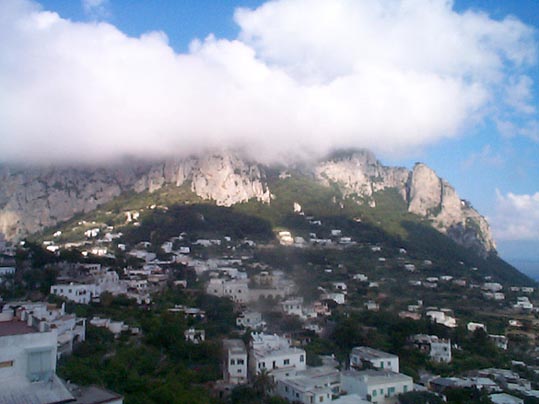 Like
the game that children and poets play, called "What do you see in that
cloud?" there's an experiment in visual perception in which you look at
an apparently random jumble of light and shadow, and try to pick out a
figure—perhaps a human face or an animal—"hidden" in the picture.
You can examine it for hours in vain, then the next day glance at it casually
and have it spring out at you like a jack-in-the-box. Then, you might
blink your eyes, look again—and it's gone. Like
the game that children and poets play, called "What do you see in that
cloud?" there's an experiment in visual perception in which you look at
an apparently random jumble of light and shadow, and try to pick out a
figure—perhaps a human face or an animal—"hidden" in the picture.
You can examine it for hours in vain, then the next day glance at it casually
and have it spring out at you like a jack-in-the-box. Then, you might
blink your eyes, look again—and it's gone.
Capri is like that. I have been looking at her profile daily for many
years from across the bay in Naples. "Her," because many claim to see
the head of a woman in the profile of Monte Solaro. Her hair
is flowing down to rest on the waters and her face is raised heavenward
as she stares off into space, perhaps playing her own games with the
clouds drifting overhead. Sometimes I see her, sometimes I don't. Perhaps
it is good that she is not always there at my beck and call.
But, whether
or not I manage to catch that glimpse of her, whenever I need a long
walk and peace and quiet, she—the island—is always there.
Strange, you say, to think of Capri in terms of solitude? Is this not
the Isle of Pleasure, boasting centuries of tales and descriptions of
lurid Hedonism? And even if you aren't a sinner, is there not an almost
obligatory hustle and bustle forced upon the visitor? How do you find
the peace and quiet.
The
"Natural Arch" on Capri
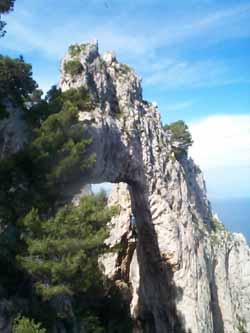 Walk. It's
amazing how long it took me to realize that. I was staring at Capri
from a short distance offshore and I remember seeing for the hundredth
and yet the first time the houses that dot the isle. I then realized
that I had no idea how all the people who live in those houses get about
when, except on a few principle roads, there is virtually no motorized
traffic at all. I set off to find out, and I discovered an extensive
network of trails, spun like a web over the island. Walk. It's
amazing how long it took me to realize that. I was staring at Capri
from a short distance offshore and I remember seeing for the hundredth
and yet the first time the houses that dot the isle. I then realized
that I had no idea how all the people who live in those houses get about
when, except on a few principle roads, there is virtually no motorized
traffic at all. I set off to find out, and I discovered an extensive
network of trails, spun like a web over the island.
I have
walked up from the Marina Grande to the top of Monte Solaro
in the midst of the tourist season and had the entire trail
to myself. I've hiked up to the Saracen Tower on Mount Barbarossa and
practiced the trombone, much to the amusement of the wildlife. I've
wandered down from the top of Monte Solaro to the small observatory
and to the church that commands the heights overlooking the town of
Capri, itself. I've hiked down the steps from Villa Fersen to
the sea and had a secluded bath in the sea, again at the height of summer
with not a soul in sight. Up to the villa of infamous Tiberius, down
to the Natural Arch, over to the red bunker that Malaparte called "home,"
down the via Krupp, and simply nowhere in particular along the
trails around Anacapri—the variations are endless.
Oplontis
 Greek historian and geographer,
Strabo (63 BC – 24 AD), wrote that the stretch of Italian coast
from Cape Miseno to Sorrento—the Gulf of Naples—seemed a
single city, so strewn was it with luxurious villas and suburbs of the
main city of Naples. The eastern end of the bay, before the land swings
out to form the Sorrentine peninsula, is of course known today as the
site of two towns that met their doom in the great eruption of Vesuvius
in 79 a.d., Pompeii and Heculaneum. Greek historian and geographer,
Strabo (63 BC – 24 AD), wrote that the stretch of Italian coast
from Cape Miseno to Sorrento—the Gulf of Naples—seemed a
single city, so strewn was it with luxurious villas and suburbs of the
main city of Naples. The eastern end of the bay, before the land swings
out to form the Sorrentine peninsula, is of course known today as the
site of two towns that met their doom in the great eruption of Vesuvius
in 79 a.d., Pompeii and Heculaneum.
There is
a third, lesser–known, and little–excavated town: Oplontis.
It lies beneath the modern–day town of Torre Annunziata, such
a short distance from Pompeii that it was almost certainly a suburb
of that larger town and—according to recent archaeological thinking—probably
the port for Pompeii, so close is it to the sea.
The only
large, significant excavation at Oplontis is the "Villa of Poppaea,"
referring to Poppaea Sabina, Nero's second wife. That is at least a
possible conclusion from an amphora fragment bearing the name "Secundus,"
one of Poppaea's servants. In any event, it was almost certainly an
imperial residence, opulently equipped as it was with a 60 x 15-meter
swimming pool, a large number of rooms, intervening gardens and courtyards,
and murals on the walls that are still splendid. Some of the extant
murals are beautiful examples of the so-called "second Pompeian style,"
depicting artificial architecture on the walls—painted windows
opened onto painted sea or landscape or ontopainted rows of columns
that fade away from the viewer through the use of perspective, all to
give the illusion of space. It was, no doubt, one of the villas that
impressed Strabo so much.
The
"peacock mural" from Oplontis. It is remarkable for the use of pseudo-perspective
in the columns and the trompe-l'oeil
effect of the bird's tail.
|
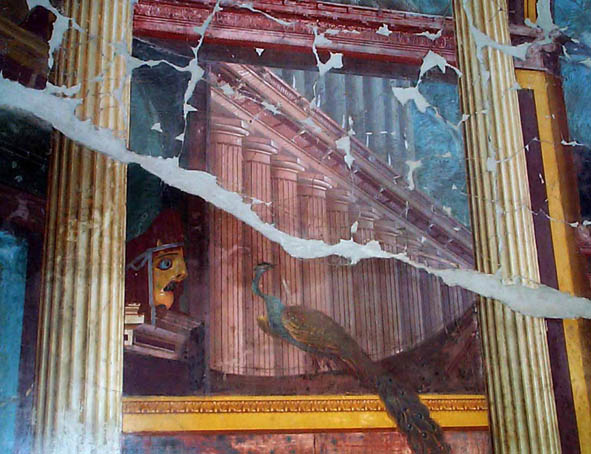 The
existence of such a regal residence is, in fact, noted in the Tabula
Peuteringiana, a medieval copy of a Roman road map. The villa and
whatever other structures made up the small town of Oplontis were buried
in the great eruption, however, and it wasn't until the 1500s that the
Spanish rulers of the Kingdom of Naples came across the ruins of the
villa while building an aqueduct. And it was not until the mid-1700s
that further excavation was undertaken in the same wave of archaeological
interest that spurred Charles III and then his son, Ferdinand IV, to
lay bare such antiquities as Pompeii and Herculaneum. Yet, Oplontis
remained—and remains—relatively unknown; the swimming pool
wasn't uncovered until the 1970s and the site, itself, was not open
to public visits until the early 1980s. The excavation is not complete
and never will be, since Oplontis, like Herculaneum, sits beneath a
modern town. To get into the site, you walk down a ramp until you are
at ground level, 79 a.d. (about 30 feet below the modern streets and
buildings that surround Oplontis). The
existence of such a regal residence is, in fact, noted in the Tabula
Peuteringiana, a medieval copy of a Roman road map. The villa and
whatever other structures made up the small town of Oplontis were buried
in the great eruption, however, and it wasn't until the 1500s that the
Spanish rulers of the Kingdom of Naples came across the ruins of the
villa while building an aqueduct. And it was not until the mid-1700s
that further excavation was undertaken in the same wave of archaeological
interest that spurred Charles III and then his son, Ferdinand IV, to
lay bare such antiquities as Pompeii and Herculaneum. Yet, Oplontis
remained—and remains—relatively unknown; the swimming pool
wasn't uncovered until the 1970s and the site, itself, was not open
to public visits until the early 1980s. The excavation is not complete
and never will be, since Oplontis, like Herculaneum, sits beneath a
modern town. To get into the site, you walk down a ramp until you are
at ground level, 79 a.d. (about 30 feet below the modern streets and
buildings that surround Oplontis).
By far
the most striking thing about Oplontis is what you don't find—human
remains. And there are no lava molds of people huddled together in death,
as there are at Pompeii. The Villa Poppaea was deserted when Vesuvius
erupted. In the wake of an earthquake that damaged the town and villa
severely in the decade before the great eruption, people had moved away
so reconstruction could take place. Presumably, the residents were elsewhere,
making typical complaints about how it took the Egyptians less time
to build the pyramids than it does for us Romans to put a few bricks
back in place, when real disaster struck.
|
